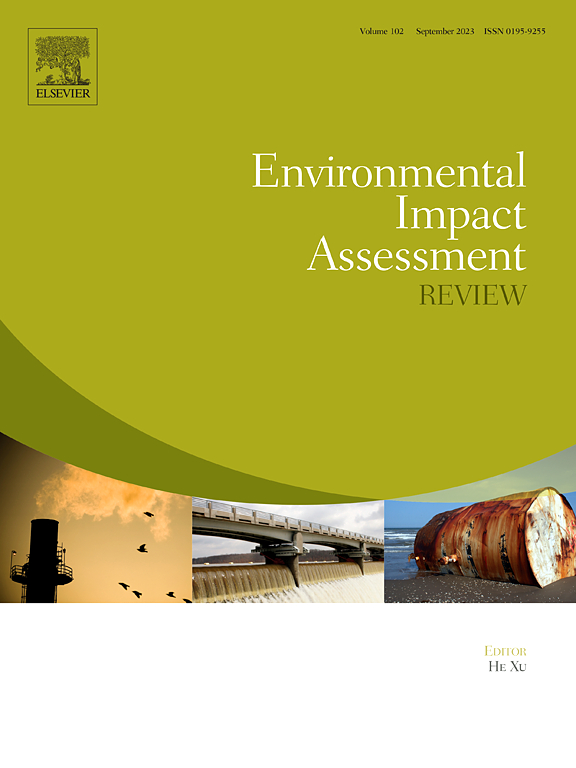Ecological risk assessment and management under the influence of multi-hazards in the alpine canyon region
IF 9.8
1区 社会学
Q1 ENVIRONMENTAL STUDIES
引用次数: 0
Abstract
Under the context of global climate change, geohazards occur frequently and often form chains, resulting in catastrophic events that cause significant loss of life and property, posing serious threats to humans and ecosystems. However, current research on the ecological risks of geohazards mainly focuses on isolated landslide or debris flow events, often overlooking the causal relationships between multi-hazards. To address this issue, we used a Bayesian network model to quantify the hazard, used landscape pattern indices to characterize ecological vulnerability, and calculated potential ecological loss based on ecosystem services, thereby comprehensively evaluating the ecological risks of geohazards. The results indicate that (1) geohazards are primarily concentrated near riverbanks and along roads, resulting from the combined effects of natural environments and human activities. (2) The ecological risks of geohazards exhibit significant spatial clustering characteristics, with medium to high-risk areas clustered linearly along rivers and roads, while low-risk areas account for the majority and are concentrated in contiguous patches, mainly located on the periphery of watersheds. The risk levels spatially align well with the distribution of geohazard points. (3) Based on ecological risk levels and composition types, four risk prevention and management zones are identified: avoidance and monitoring early warning zones, ecological protection and restoration zones, avoidance and protection zones, and natural adaptation and regulation zones. For each zone, the article proposes targeted action plans to address the escalating challenges of geohazards and ecological risks. This study aims to enhance the effective management of ecological risks and provide guidance for geohazard prevention and ecological environmental protection.
高寒峡谷区多灾害影响下的生态风险评价与管理
在全球气候变化背景下,地质灾害频繁发生,往往形成连锁,造成重大生命财产损失的灾难性事件,对人类和生态系统构成严重威胁。然而,目前对地质灾害生态风险的研究主要集中在孤立的滑坡或泥石流事件上,往往忽视了多种灾害之间的因果关系。为此,利用贝叶斯网络模型量化灾害风险,利用景观格局指数表征生态脆弱性,并基于生态系统服务功能计算潜在生态损失,综合评价地质灾害生态风险。结果表明:(1)地质灾害主要集中在河堤附近和道路沿线,是自然环境和人类活动共同作用的结果。②地质灾害生态风险表现出明显的空间集聚特征,中高风险区沿河流、道路呈线性集聚,低风险区占多数,且集中在连续斑块中,主要分布在流域周边;风险等级在空间上与地质灾害点分布一致。(3)根据生态风险等级和构成类型,划分出规避与监测预警区、生态保护与修复区、规避与保护区、自然适应与调控区4个风险防控区。针对每个区域,文章提出了有针对性的行动计划,以应对日益加剧的地质灾害和生态风险挑战。本研究旨在加强生态风险的有效管理,为地质灾害防治和生态环境保护提供指导。
本文章由计算机程序翻译,如有差异,请以英文原文为准。
求助全文
约1分钟内获得全文
求助全文
来源期刊

Environmental Impact Assessment Review
ENVIRONMENTAL STUDIES-
CiteScore
12.60
自引率
10.10%
发文量
200
审稿时长
33 days
期刊介绍:
Environmental Impact Assessment Review is an interdisciplinary journal that serves a global audience of practitioners, policymakers, and academics involved in assessing the environmental impact of policies, projects, processes, and products. The journal focuses on innovative theory and practice in environmental impact assessment (EIA). Papers are expected to present innovative ideas, be topical, and coherent. The journal emphasizes concepts, methods, techniques, approaches, and systems related to EIA theory and practice.
 求助内容:
求助内容: 应助结果提醒方式:
应助结果提醒方式:


